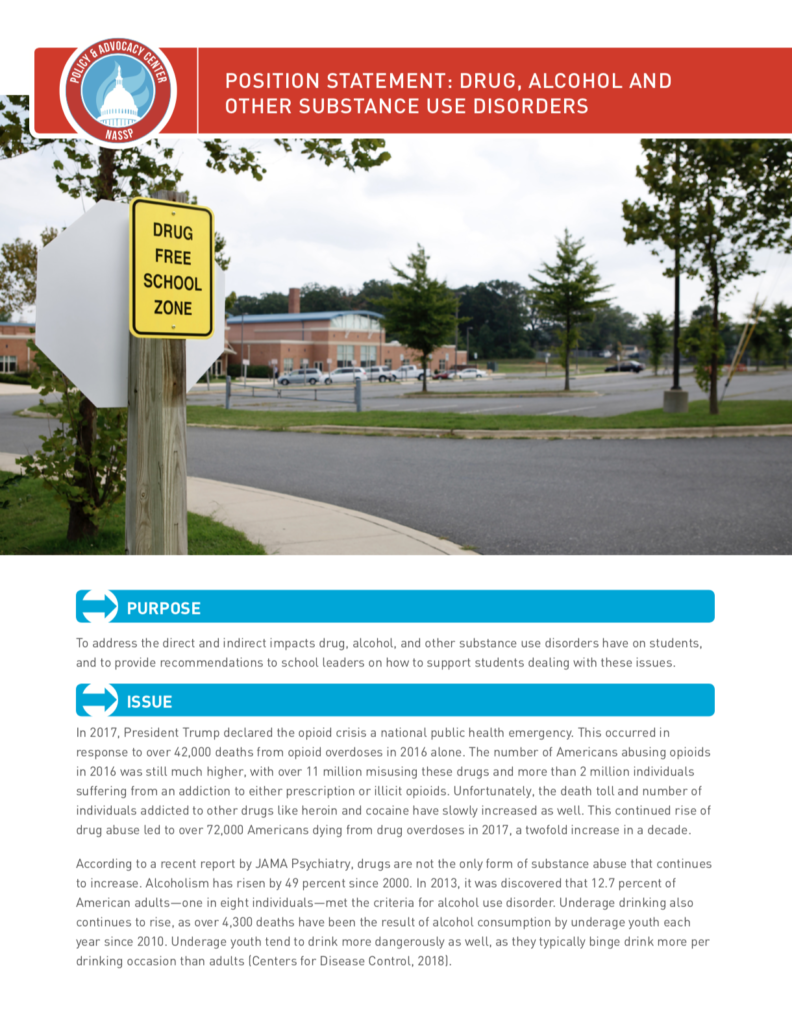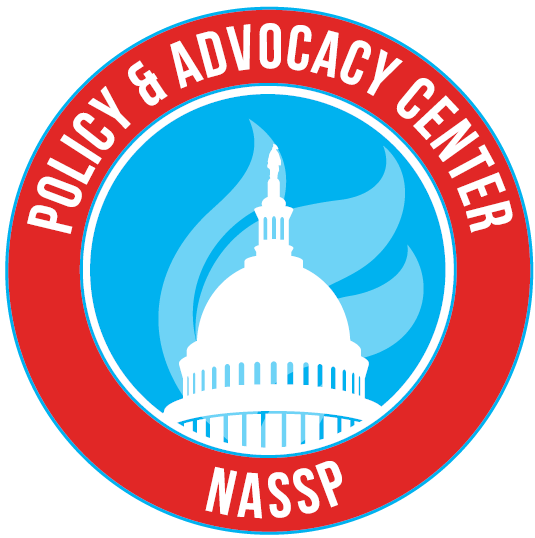To address the direct and indirect impacts drug, alcohol, and other substance use disorders have on students, and to provide recommendations to school leaders on how to support students dealing with these issues.
In 2017, President Trump declared the opioid crisis a national public health emergency. This occurred in response to over 42,000 deaths from opioid overdoses in 2016 alone. The number of Americans abusing opioids in 2016 was still much higher, with over 11 million misusing these drugs and more than 2 million individuals suffering from an addiction to either prescription or illicit opioids. Unfortunately, the death toll and number of individuals addicted to other drugs like heroin and cocaine have slowly increased as well. This continued rise of drug abuse led to over 72,000 Americans dying from drug overdoses in 2017, a twofold increase in a decade.
According to a recent report by JAMA Psychiatry, drugs are not the only form of substance abuse that continues to increase. Alcoholism has risen by 49 percent since 2000. In 2013, it was discovered that 12.7 percent of American adults—one in eight individuals—met the criteria for alcohol use disorder. Underage drinking also continues to rise, as over 4,300 deaths have been the result of alcohol consumption by underage youth each year since 2010. Underage youth tend to drink more dangerously as well, as they typically binge drink more per drinking occasion than adults (Centers for Disease Control, 2018).
Student achievement varies due to a variety of factors, like interactions with their parents and concerns at home (Bertolini, 2012). Substance abuse by a student can play a direct role on their ability to succeed. Students involved in direct substance abuse often have more absences, social issues, memory problems, and suffer from a higher risk of health issues and suicide.
While drug and alcohol abuse by a parent may play a more indirect role in a student’s ability to succeed in the classroom, it does not make it any less impactful. For example, students living with a parent or guardian struggling with opioid addiction are missing more days of school. There has also been an increase in students who are displaced or orphaned due to a parent’s drug abuse, leaving these students to now live with either their grandparents or in foster care (Rafa, 2018). Furthermore, substance abuse often leads to health problems for individuals, which can directly impact a guardian’s ability to provide the necessary care students need.
As more and more students are affected by substance abuse, schools have been called upon to provide services and support. Unfortunately, many areas are ill-equipped to handle the drastic increase in affected students. For example, by the 2014–15 school year, there was only one school counselor for every 482 students. The recommended ratio from the American School Counseling Association is one school counselor for every 250 students. The lack of funding for schools to address these issues has made it increasingly difficult for them to offer the necessary training, education, and support needed to properly aid students affected by substance abuse.
Guiding Principles
- A variety of factors both inside and outside of school impact student achievement.
- Students are most poised to succeed when they have comforting environments at both home and school.
- School leaders must foster and nurture an intentional focus on wellness, because healthy students and adults learn and interact productively.
- All schools should educate students about the negative impacts of drug and alcohol abuse. Schools must also offer support for students and families dealing with substance abuse.
Recommendations
Recommendations for Federal Policymakers
- Allow for blended, flexible use of funding streams in education and mental health services.
- Improve staffing ratios to allow delivery of a full range of services and effective school-community partnerships.
- Fully fund programs, like Supporting Effective Instruction State Grants, that accommodate educator professional development to support students dealing with trauma.
- Provide additional support for federal agencies to better educate the public about the dangers of substance abuse.
Recommendations for State Policymakers
- Implement a statewide model that helps schools move from a model of policing drug and alcohol abuse to one of prevention.
- Provide training for school nurses or other school personnel to maintain and administer life-saving measures to combat overdoses on school grounds.
- Require the inclusion of age-appropriate substance misuse and abuse instruction in health curricula.
Recommendations for District Leaders
- Ensure that substance abuse components being used in current curricula are up to date. An updated curriculum should include information on substance abuse at all levels of education.
- Make arrangements either inside or outside of school to offer effective substance abuse treatment.
- Implement multi-tiered systems of support for students that encompass prevention, wellness promotion, and interventions.
- Allow schools to employ qualified staff whose sole purpose is to focus on student wellness.
- Focus on prevention and effective interventions as responses to disciplinary matters for students dealing with drug issues, including Positive Behavioral Interventions and Supports, mentoring, mental health counseling, restitution, and community service programs.
- Develop partnerships with local substance abuse programs to aid students and families dealing with these issues.
Recommendations for School Leaders
- Create a safe environment and positive culture to support all students.
- Create a support network for students in recovery and students whose family members are suffering from addiction.
- Incorporate trauma-informed practices in schools.
- Work with school personnel to identify and assist students who are displaying factors tied to substance abuse, such as chronic absenteeism.
- Assist in training designated school personnel on how to aid students suffering directly or indirectly from substance abuse.
- Introduce measures that aid students dealing with substance abuse and only enforce consequences that could lead to further behavioral or academic issues, such as suspensions, after all other options have been exhausted.
Resources
Bertolini, K., Stremmel, A., & Thorngren, J. (2012). Student achievement factors. South Dakota State University College of Education and Human Sciences Department of Teaching, Learning and Leadership.
Centers for Disease Control and Prevention. (2017). Drug overdose death data. Retrieved from https://www.cdc.gov/drugoverdose/data/statedeaths.html
Centers for Disease Control and Prevention. (2018). Fact sheets – Alcohol use and your health. Retrieved from https://www.cdc.gov/alcohol/fact-sheets/alcohol-use.htm
Centers for Disease Control and Prevention. (2018). Fact sheets – Underage drinking. Retrieved from https://www.cdc.gov/alcohol/fact-sheets/underage-drinking.htm
Cowan, K.C., Vaillancourt, K., Rossen, E., & Pollitt, K. (2013). A framework for safe and successful schools. Bethesda, MD: National Association of School Psychologists.
Grant B.F., Chou S.P., Saha T.D., et al (2017). Prevalence of 12-month alcohol use, high-risk drinking, and DSM-IV alcohol use disorder in the United States, 2001-2002 to 2012-2013. JAMA Psychiatry, 74(9):911-923. Retrieved from https://jamanetwork.com/journals/jamapsychiatry/article-abstract/2647079
Healy, M. (2018). Killer epidemic: Schools deal with repercussions of the nation’s opioid crisis. American School Board Journal.
Hefling, Kimberly. (2018). Cash-strapped schools struggle to help the children of the opioid epidemic. Politico. Retrieved from https://www.politico.com/story/2018/06/18/opioid-epidemic-childen-schools-649564
National Association of Secondary School Principals. (2018). Building ranks: A comprehensive framework for effective school leaders. Retrieved from https://www.nassp.org/professional-learning/building-ranks-for-school-leaders/
National Association of Secondary School Principals. (2015). Position statement: School discipline. Retrieved from https://www.nassp.org/policy-advocacy-center/nassp-position-statements/school-discipline/
National Institute on Drug Abuse. (2018). Overdose death rates. Retrieved from https://www.drugabuse.gov/related-topics/trends-statistics/overdose-death-rates
National Institute on Drug Abuse. (2003). Preventing drug use among children and adolescents. Bethesda, MD: National Institutes of Health.
Phenicie, C. (2018). Tackling the opioid epidemic: Senate hearing touts 3 ways education can play a role, from better drug prevention to discipline reform. The 74 Million. Retrieved from https://www.the74million.org/tackling-the-opioid-epidemic-senate-hearing-touts-3-ways-education-can-play-a-role-from-better-drug-prevention-to-discipline-reform/
Plackis, Christine. (2011). Academic success for students in families affected by alcoholism. Principal Leadership, 11(4).
Rafa, A. (2018). How is the opioid epidemic affecting schools and students? Retrieved from https://www.ecs.org/how-is-the-opioid-epidemic-affecting-schools-and-students/
U.S. Department of Education. (2018). Combatting the opioid crisis. Retrieved from https://blog.ed.gov/2018/06/combating-the-opioid-crisis/
U.S. Department of Education. (2018). Combatting the opioid crisis: School, students, families. Retrieved from https://www.ed.gov/opioids


